Why did hasekura tsunenaga travel to south america
From Japan to Civitavecchia: Hasekura Tsunenaga’s trip
Hasekura Tsunenaga (1571 – 7 August 1622) was a relevant Japanese samurai at the service of Date Masamune, daimyo of Sendai, famous for leading many delegations that took him travelling all around the world.
In 1615, during a mission aimed to meet Pope Paul V in Rome, the ambassador disembarked at the Port of Civitavecchia, where he stayed for about two weeks over which he made friends with the citizens. For this reason, Civitavecchia and the Japanese city of Ishinomaki are to date twin cities.
From this port city starts the samurai’s extraordinary trip, which we are ready to tell in words of Roberta Galletta, historian of Civitavecchia and author of the book “La Darsena Romana – Il porticciolo di Civitavecchia” (“Roman Harbour – Small Tourist Port of Civitavecchia”)
THE GREAT JOURNEY OF HASEKURA TSUNEGAGA
On October 18, 1615, by the time of the Papal State Port, Hasekura Rokuemon Tsunenaga disembarked at Civitavecchia after a long journey that had begun on October 28, 1613 from the port of Ishinomaki. Two long years of navigation during which the samurai crossed two oceans, the Pacific and the Atlantic, with the aim to meet in Rome Pope Paul V.
The samurai, who was born in Japan in 1571, before undertaking this long and important diplomatic action in Europe (1615-1620), which has its starting from its landing in Civitavecchia, had already led an embassy in Mexico.
Accompanied by Spanish Father S otelo and from 15 other delegates, Tsunenaga was warmly welcomed by the authorities and the citizens of Civitavecchia. Then he left again, after two weeks of stay in the city, this time for Rome.
This trip represented the only diplomatic and political response, during the years of the great navigations, of East Asia towards the West.
On 3 November, the Japanese delegation was finally received by the Pope in the Vatican to bring a message from Date Masamune, delivered to the pontiff by Hasekura in person. The letter, preciously decorated with gold, asked Paul V to open a trade treaty between Japan and Mexico and to send Christian missionaries to his kingdom.
The Pope agreed to send missionaries, but left the decision of the trade treaty to the king of Spain, being the economic issue too thorny in those years of great commercial expansion.
The proof of the collaboration is reported in a letter that Paul V wrote to the Date Masamune, of which a copy is preserved in the Vatican.
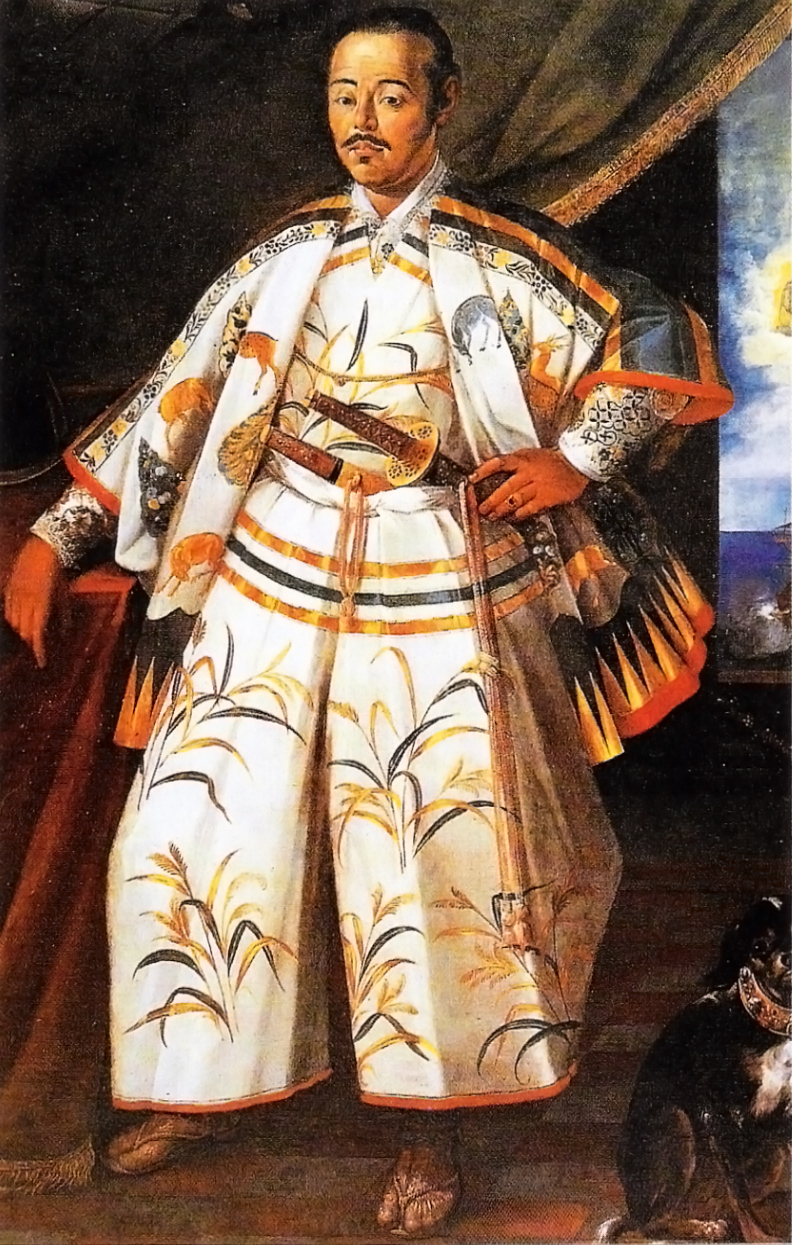
Portrait from 1615 of Hasekura Tsunegaga in Rome
The Japanese were the first Asian country to officially enter the city symbol of Christianity. They remained in Rome until January 4, 1616, and then they left to return to Japan, bringing back to their country a part of Civitavecchia and its harbor.
The importance of this episode is brought to light by the twinning of Civitavecchia with the city of Ishinomaki in 1971, in honor of the old friendship that binds the two port towns, so distant and yet so close.
A statue dedicated to samurai Hasekura Tsunenaga is located in Viale Guglielmo Marconi near Porta Livorno, a monumental passage that connects the city with its port.
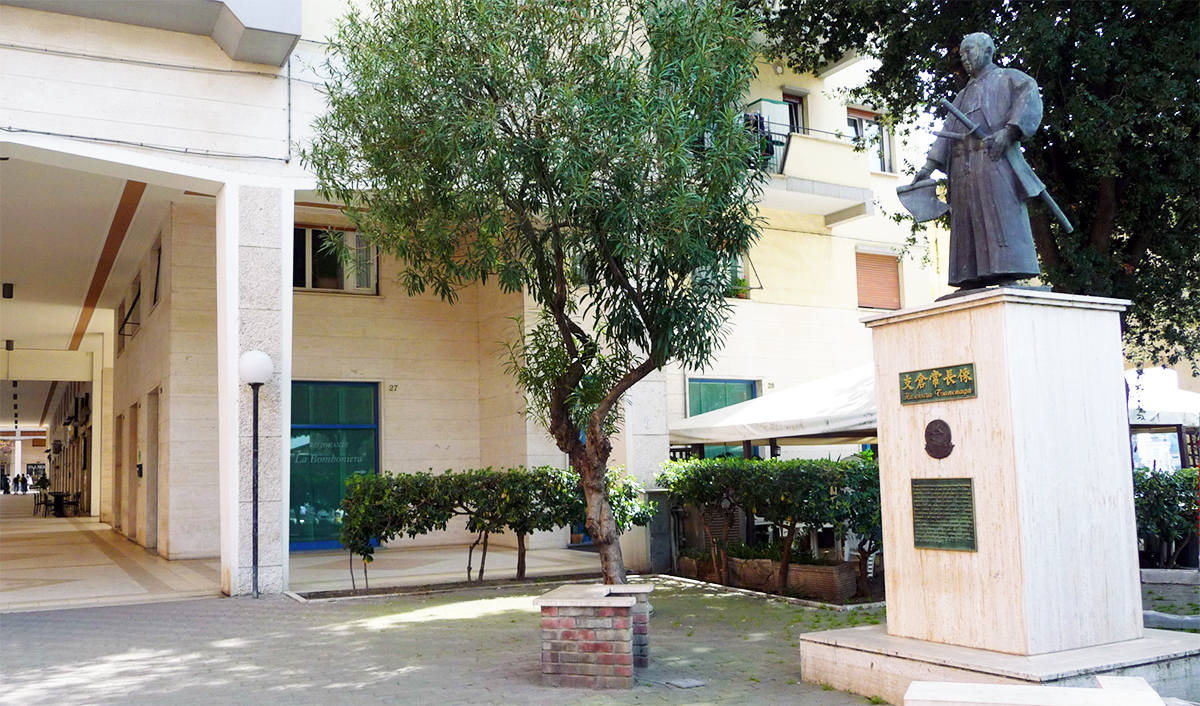
The statue dedicated to samurai Hasekura Tsunenaga is located in Viale Guglielmo Marconi close to Porta Livorno
MARTYRDOM OF THE FIRST JAPANESE CHRISTIANS
The journey was also a chance to heal a relationship between two different and far away worlds that was born hardly in 1549 and culminated in the tragedy of 26 Japanese martyrs killed in 1597.
To understand this we have to take a step back to 1549, the year in which the Jesuit fathers, led by Saint Francis Xavier, departed from Italy to Japan to convert to Christianity the Japanese population. The mission succeeded to convert so many people, that the locals were irritated (about 300,000 faithful already in 1587 mainly in Nagasaki).
The shogun of the Japanese crown emanated then a deportation order against the jesuits, representing the only religious Christian order i n Japan.
When in 1593 arrived to Japan also the Franciscan friars, implementing a public evangelism without prudence, the story got complicated causing an even harder reaction of the shogun. He ordered on 9 December 1596 to arrest Franciscans, Jesuits and neophytes Japanese Christians. It turned into a martyrdom of 26 Christians, whose crucifixion took place on 5 February 1597.
In memory of the tragedy of the Christian martyrs and the strong bond that Civitavecchia has with Japan, the city has dedicated a church to the Japanese Martyrs, located between Viale della Vittoria and Via Italo Stegher.
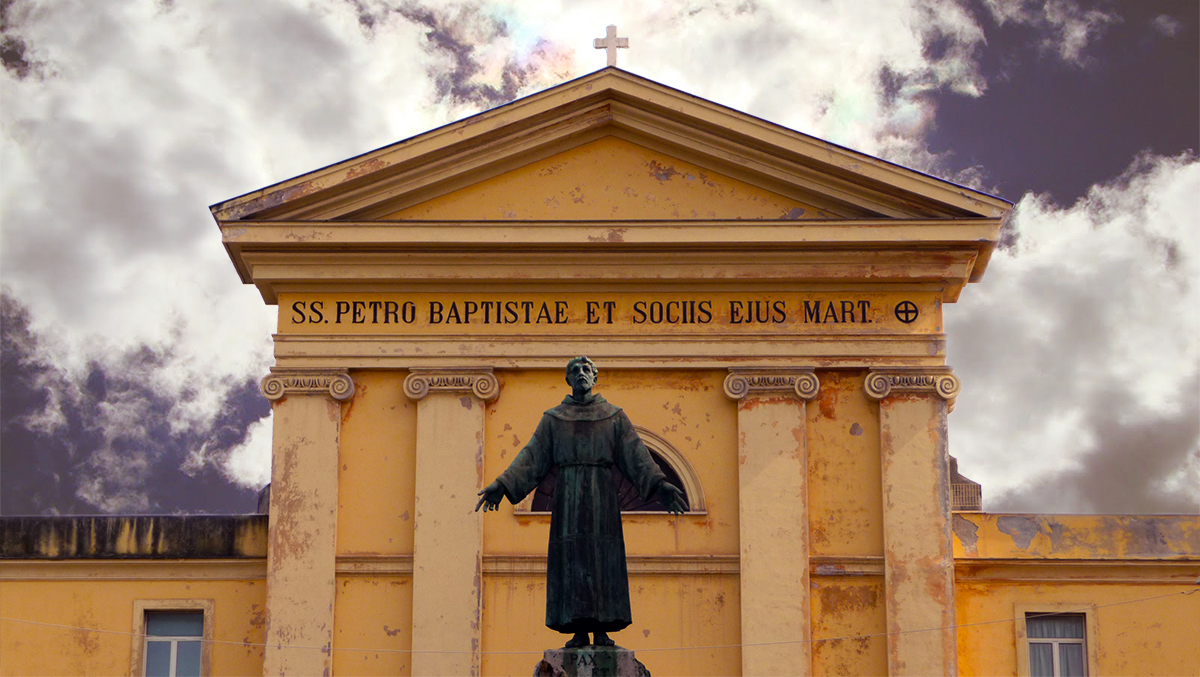
The Church of the Japanese Martyrs in Civitavecchia
The inside of the building, consecrated in 1862, after its reconstruction followed the devastations of bombings in 1943-44, is frescoed, with images that remind us of the history of the Japanese martyrs between 1951 and 1954, by the famous Japanese painter Luca Hasegawa.

Madonna with the Kimono – Particular of the Church of the Japanese Martyrs in Civitavecchia
In the center of vault of the apse, between Saint Francis Xavier and St. Francis of Assisi, is depicted the Madonna with the Kimono, while at the sides of the apse Hasegawa wanted to pay tribute to Santa Fermina, patroness of Civitavecchia, by putting her in front of the samurai Hasekura Tsunenaga, the first Japanese ambassador in Europe, to symbolize the strong bond between the East and the West and between the two cities of Ishinomaki and Civitavecchia.
SOME CURIOSITIES’
Few know that in one of the rooms of the Quirinal, more precisely inside of the Sala dei Corazzieri, in a lunette of the ceiling is a marvelous frescoed painting depicting our Hasekura Tsunenaga, in the company of other members of the Japanese delegation and Father Sotelo.
The marvelous painting, commissioned by Pope Paul V himself, pays homage to the visit of the samurai ambassador. It was created by the Roman B aroque painter Giovanni Lanfranco, who was a pupil of Caracci.
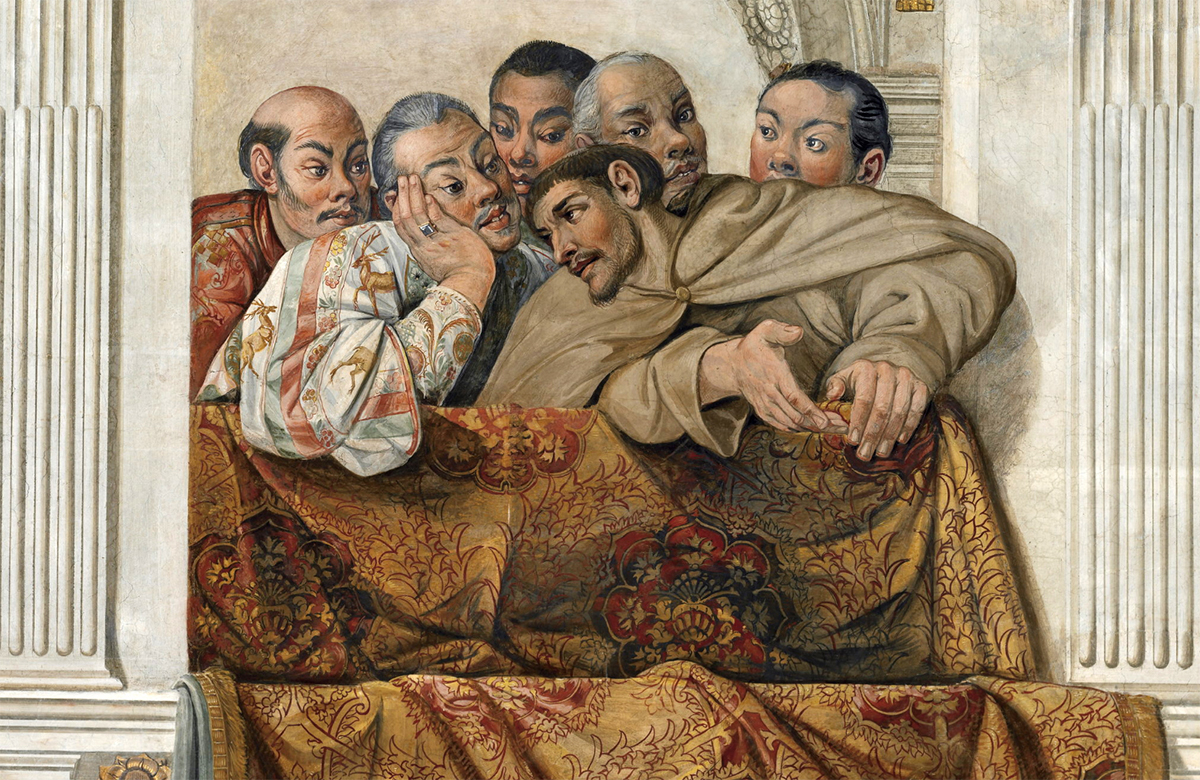
Particular of the painting portrarying the delegation of Hasekura Tsunenaga – Quirinal, Salone dei Corrazzieri
Why did hasekura tsunenaga travel to south america
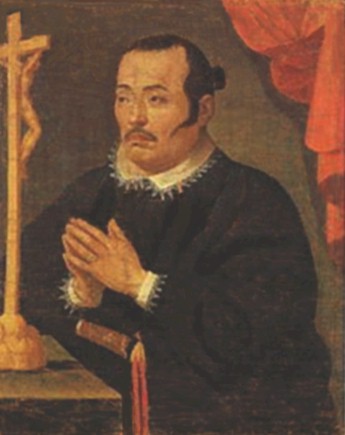
Hasekura Tsunenaga
(1571 – 1622)
The Voyage of Hasekura Tsunenaga (1613-1620) was remarkable in its scope and vision standing in hard contrast to the policies of the Tokugawa in their attempts to control the political climate, foreign trade and impact of the outside world on Japan in the early 17th Century. This journey wrote a remarkable chapter in Japanese History.This voyage of a delegation of 180 men was begun in 1613 at the time Jamestown the first English Colony in America was just seven years old and struggling to establish a foothold in Virginia. Hasekura’s mission traveled from Japan to Europe crossing both the Pacific and Atlanitc and returned again to Japan arriving back in Japan in 1620, the same year that Plymouth Colony was established by a group of 140 Pilgrims coming to America from England by the way of Holland.
This journey was the highwater mark of the use of ships for the Japanese in the 17th century.
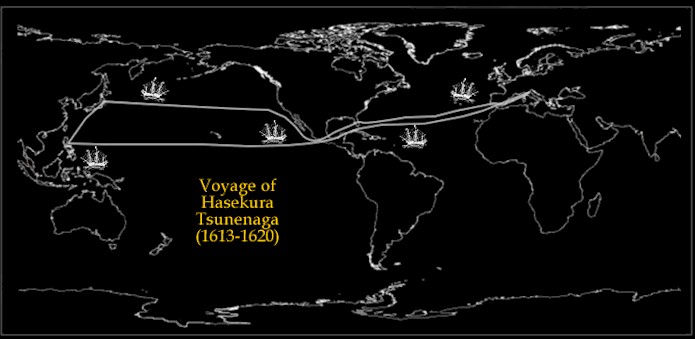
The Voyage of Hasekura Tsunenaga and his emissaries to Rome
crossed two oceans and Mexico between Alcopulco and Veracruz
becoming the first transoceanic voyage made in a galleon
built entirely by Japanese Shipwrights
Hasekura Tsunenaga was a retainer of Date Masamune the founder and Daiymo of Sendai Japan. He led a political delegation to Mexico and Europe (1613 – 20) and was the first Japanese political envoy to visit the American continent. In the early 17th century Japanese merchants were making efforts to trade with the west on their own. In July of 1611 an emissary under Sebastion Viscaino brought back from Mexico a group of Japanese merchants who had traveled there with Rodrigo Vivero Y Velasco to establish trading relations with Mexico in the previous year. This effort to establish trading ties with Mexico inspired Date Masamune to send his own delegation to seek trade with Mexico and Southern Europe. Date Masamune appointed Hasekura Tsunenaga, a veteran of Toyotomi Hideyoshi’s invasions of Korea 1n 1592 and 1597, as his personal representative to lead this delegation.

Date Masamune the founder and Diaymo of Sendai Japan (Born 1567 – Died 1636)
At the onset of Hasekura’s mission it seems obvious that Date Masamune was functioning with a different set of goals and aspirations from those of the Tokugawa. Date was prepared to embrace Christian missionaries and trade with the west where the Tokugawa was motivated by gaining control of the foreign trade to the exclusion of foreign interests in Japan. In addition Date undertook the building of seaworthy ships that could handle the transoceanic voyages, an undertaking that Tokugawa Ieyasu had attempted with limited success with the English mariner William Adams. For this purpose, approximately 4,400 workers led by Vizcaino from New Hispania and ship-building carpenters delegated from the Tokugawa government built a 500-ton class galleon in just six months. This was the largest of ships of this kind built by the Japanese. The largest ship built under the supervison of William Adams, had been 120 tons.
In October 1613 Hasekura, with a delegation of 180 Japanese, set out for Acapulco in the galleon built by Japanese shipwrights under Spanish supervision. The ship was named the San Juan Bautista (Saint John the Baptist). Its very name indicates the interest Date Masamune had in Christianity at the time. Masamune’s interest in Christianity is further indicated by the letter which he sent with his envoys to the Pope, one line which said “I’ll offer my land for a base of your missionary work. Send us as many padres as possible.”
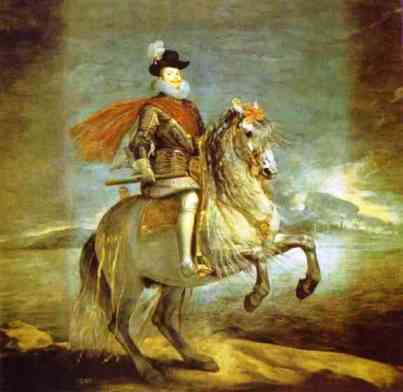
Philip III of Spain reign (1598-1621) by Diego Velázquez
Having just crossed the Pacific Ocean Hasekura Tsunenaga had an audience with the Mexican viceroy in 1614. After traversing Mexico between Acapulco and Vera cruz and the Atlantic Ocean in 1615 he sailed for Spain where he met with the Spanish monarch Philip III (1598-1621). While in Spain he was baptized a Christian. The ceremony was conducted by the Archbishop of Toledo and the Duke of Lerma was desginated as Hasekura’s Godfather. Hasekura’a delegation stayed in Spain for eight months before traveling on to Italy.
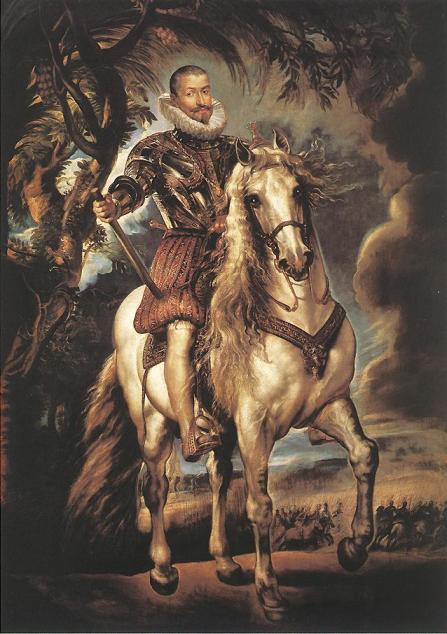
Hasekura Tsunenaga’s Christian Godfather the Durk of Lerma
Painting By Peter Paul Rubens Circa 1603
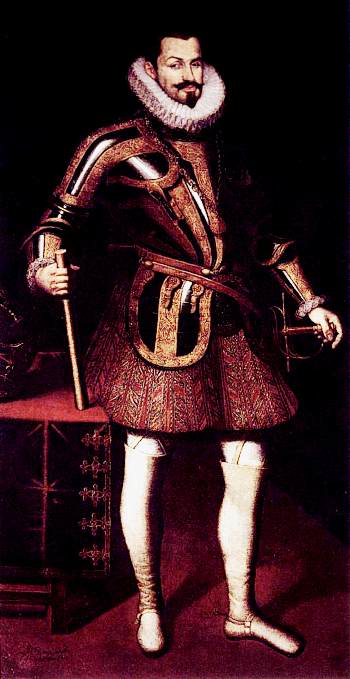
The duke of Lerma By Titian
The Duke of Lerma was the main administrator of Phillip III’s rule and in effect was the de facto ruler of Spain, being designated as Haskekura’s Catholic Godfather demonstrates the importance the Spanish leadership put on the visit of Date’s delegation. Had Ieyasu’s policies toward the Catholic influence in Japan been different the ground work for the future would have been firmly in Masumune’s court, however the doors were being shut to further missionary influences in Japan even as Hasekura’s delegation were being shown the courts of Spain and Italy.
In Rome he had an audience with Pope Paul V (1605-1621) where Hasekura and his delegates were well received, to the extent that Pope Paul V even granted Hasekura Roman citizenship.
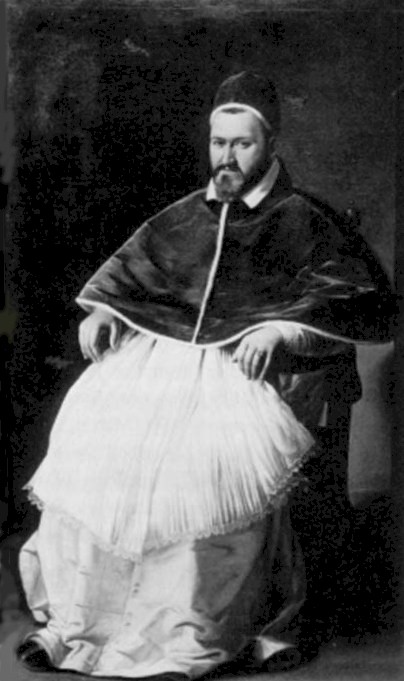
Pope Paul V (1605-1621) By Caravaggio
Hasekura arrived in Rome in 1615 the same year Galileo Galilei first went before the Roman Inquisition to present his findings against geocentricism and it was the same Pope Paul V who granted Hasekura his Roman Citizenship who repressed the teachings of Copernicus and Galileo Galilei in the following year labeling them as heretical.
During the course of Hasekura’s mission, back in Japan in February of 1614, Tokugawa Hidetada had issued another edict expelling Christian priests from Japan and this resulted in a hardening of the Spanish attitude toward trade with Japan. Hasekura had met his objectives and accomplished his mission however because of the repression of Christian Missionaries was becoming the political agenda of the Tokogawa, Hasekura failed to secure open trade agreements with the west for Date Masamune. Thirty of Hasekura’s delegates remained in Spain knowing that by returning to Japan they would be persecuted as Christians.
The Japanese mission was the topic of much discussion within the Jesuits circle in Rome and the motives for sending this mission to Rome was hotly debated in view of what the church understood the current policies of the Tokugawa to be. The politcal climate in Japan and the recent restrictions made by the Tokugawa against Christian missionaries was well known and success of the mission was compromised by the differences between the statements made by Date Masumune and the hard line taken by the Tokugawa against foreign missionaries. It was clear that although Masumune had sent his trade delegation to Rome that back in Japan Date ruled at the discretion and favor of the Tokugawa and that it was the policies of the Tokugawa that the Church had to be most concerned with.
Hasekura Tsunenaga and his remaining delegates made the return trip home to Japan making a stop over in the Philippines. The delegation remained in the Philippines, another important Japanese trading colony, and after two years in the Philippines Hasekura returned to Japan in September 1620. Despite the fact that this mission had been received favorably, and there was great European interest in Japan, Date Masamune was forced to abandoned his efforts at diplomacy and trade with the west after the political agenda of the Tokugawa Shogunate banned Christianity in Japan and began to severely limit and control Japan’s contact with the rest of the world. Date Masamune’s focus would shift from foreign diplomacy to saving his own political career in Japan where he would have to again prove his loyalty to the Tokogawa despite the evidence of his pro western leanings.
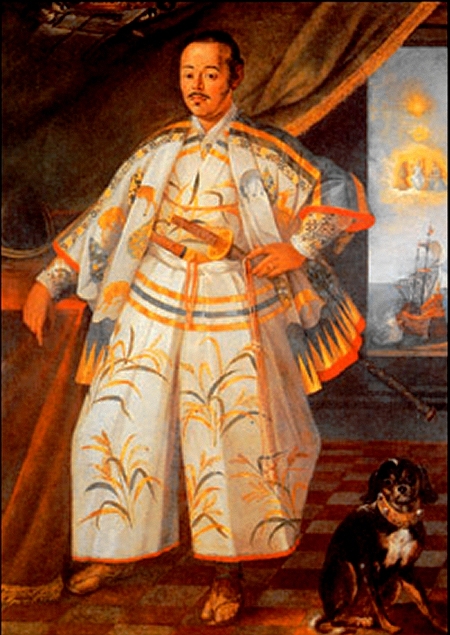
Hasekura’s portrait done during his mission
in Rome in 1615 by Claude Deruet
The differences between the outlooks of the two leaders can noted in the letters of Tokugawa Ieyasu and Date Masamune. In Ieyasu’s letter to Pope Paul V he stated “I don’t mind if you take advantage of coming to Japan to make a profit but don’t spread Christianity.” On the other hand, Date’s letter said “I’ll offer my land for a base of your missionary work. Send us as many padres as possible.”
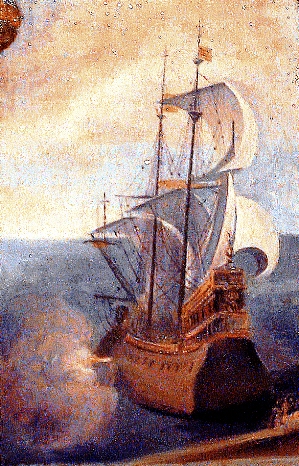
Ship Detail from Hasekura Painting
Because of their different outlooks on trade with the west and the desirability of having Christian missionaries in Japan Date Masamune would come under suspicion of plotting to overthrow the Tokugawa and the political climate in Date’s provinces would require him to prove again his loyalty to the Tokugawa. The Tokugawa judged to a large degree the extent of this loyalty on how Date dealt with the known Christian subjects within his domain.
After Ieaysu’s death the task would fall to Date Masumune to finance the building his mortuary temple. This undertaking would drain his financial coffers and allow the Shogunate to keep his political allegiance to the Tokugawa under constant scrutiny. After Hasekura’s return Christain activities in Japan would be severly curtailed by the Tokugawa.
To learn more of this epic adventure read Shusaku Endo’s historical novel “Samurai”.
Hasekura Tsunenaga’s , mission would be the one and only journey of its kind using ships in the 17th century in Japanese History.
The life and times of St. Francis Xavier, 1512- 1552
Page: 1
Xavier meets Otomo Sorin the King of Bungo,1550
Page: 2
William Adams arrives in Japan, 1600
Page: 3
The Epic Journey of Hasekura Tsunenaga, 1613-1620
Page: 4
James I king of England (1603-1625) and his personal correspondence with Tokugawa Ieyasu Shogun of Japan ( 1600-1616)
Page: 5
T he life and times of Hosokawa Sansai . (1564 – 1645)
Page 6
This Page was co-authored by Chester Comstock in co-operation with Kanayama, For additional information on Kanayama and his collection of Japanese Antiquities from the 16th and 17th Centuries see:
Kanayama Discusses Sukashi Tsuba
Chester Comstock is the Publisher and Editor of Artsales.com and the founder and owner of Comstock Sculpture Studio.
Why did hasekura tsunenaga travel to south america

Hasekura Tsunenaga
(1571 – 1622)
The Voyage of Hasekura Tsunenaga (1613-1620) was remarkable in its scope and vision standing in hard contrast to the policies of the Tokugawa in their attempts to control the political climate, foreign trade and impact of the outside world on Japan in the early 17th Century. This journey wrote a remarkable chapter in Japanese History.This voyage of a delegation of 180 men was begun in 1613 at the time Jamestown the first English Colony in America was just seven years old and struggling to establish a foothold in Virginia. Hasekura’s mission traveled from Japan to Europe crossing both the Pacific and Atlanitc and returned again to Japan arriving back in Japan in 1620, the same year that Plymouth Colony was established by a group of 140 Pilgrims coming to America from England by the way of Holland.
This journey was the highwater mark of the use of ships for the Japanese in the 17th century.

The Voyage of Hasekura Tsunenaga and his emissaries to Rome
crossed two oceans and Mexico between Alcopulco and Veracruz
becoming the first transoceanic voyage made in a galleon
built entirely by Japanese Shipwrights
Hasekura Tsunenaga was a retainer of Date Masamune the founder and Daiymo of Sendai Japan. He led a political delegation to Mexico and Europe (1613 – 20) and was the first Japanese political envoy to visit the American continent. In the early 17th century Japanese merchants were making efforts to trade with the west on their own. In July of 1611 an emissary under Sebastion Viscaino brought back from Mexico a group of Japanese merchants who had traveled there with Rodrigo Vivero Y Velasco to establish trading relations with Mexico in the previous year. This effort to establish trading ties with Mexico inspired Date Masamune to send his own delegation to seek trade with Mexico and Southern Europe. Date Masamune appointed Hasekura Tsunenaga, a veteran of Toyotomi Hideyoshi’s invasions of Korea 1n 1592 and 1597, as his personal representative to lead this delegation.

Date Masamune the founder and Diaymo of Sendai Japan (Born 1567 – Died 1636)
At the onset of Hasekura’s mission it seems obvious that Date Masamune was functioning with a different set of goals and aspirations from those of the Tokugawa. Date was prepared to embrace Christian missionaries and trade with the west where the Tokugawa was motivated by gaining control of the foreign trade to the exclusion of foreign interests in Japan. In addition Date undertook the building of seaworthy ships that could handle the transoceanic voyages, an undertaking that Tokugawa Ieyasu had attempted with limited success with the English mariner William Adams. For this purpose, approximately 4,400 workers led by Vizcaino from New Hispania and ship-building carpenters delegated from the Tokugawa government built a 500-ton class galleon in just six months. This was the largest of ships of this kind built by the Japanese. The largest ship built under the supervison of William Adams, had been 120 tons.
In October 1613 Hasekura, with a delegation of 180 Japanese, set out for Acapulco in the galleon built by Japanese shipwrights under Spanish supervision. The ship was named the San Juan Bautista (Saint John the Baptist). Its very name indicates the interest Date Masamune had in Christianity at the time. Masamune’s interest in Christianity is further indicated by the letter which he sent with his envoys to the Pope, one line which said “I’ll offer my land for a base of your missionary work. Send us as many padres as possible.”

Philip III of Spain reign (1598-1621) by Diego Velázquez
Having just crossed the Pacific Ocean Hasekura Tsunenaga had an audience with the Mexican viceroy in 1614. After traversing Mexico between Acapulco and Vera cruz and the Atlantic Ocean in 1615 he sailed for Spain where he met with the Spanish monarch Philip III (1598-1621). While in Spain he was baptized a Christian. The ceremony was conducted by the Archbishop of Toledo and the Duke of Lerma was desginated as Hasekura’s Godfather. Hasekura’a delegation stayed in Spain for eight months before traveling on to Italy.

Hasekura Tsunenaga’s Christian Godfather the Durk of Lerma
Painting By Peter Paul Rubens Circa 1603

The duke of Lerma By Titian
The Duke of Lerma was the main administrator of Phillip III’s rule and in effect was the de facto ruler of Spain, being designated as Haskekura’s Catholic Godfather demonstrates the importance the Spanish leadership put on the visit of Date’s delegation. Had Ieyasu’s policies toward the Catholic influence in Japan been different the ground work for the future would have been firmly in Masumune’s court, however the doors were being shut to further missionary influences in Japan even as Hasekura’s delegation were being shown the courts of Spain and Italy.
In Rome he had an audience with Pope Paul V (1605-1621) where Hasekura and his delegates were well received, to the extent that Pope Paul V even granted Hasekura Roman citizenship.

Pope Paul V (1605-1621) By Caravaggio
Hasekura arrived in Rome in 1615 the same year Galileo Galilei first went before the Roman Inquisition to present his findings against geocentricism and it was the same Pope Paul V who granted Hasekura his Roman Citizenship who repressed the teachings of Copernicus and Galileo Galilei in the following year labeling them as heretical.
During the course of Hasekura’s mission, back in Japan in February of 1614, Tokugawa Hidetada had issued another edict expelling Christian priests from Japan and this resulted in a hardening of the Spanish attitude toward trade with Japan. Hasekura had met his objectives and accomplished his mission however because of the repression of Christian Missionaries was becoming the political agenda of the Tokogawa, Hasekura failed to secure open trade agreements with the west for Date Masamune. Thirty of Hasekura’s delegates remained in Spain knowing that by returning to Japan they would be persecuted as Christians.
The Japanese mission was the topic of much discussion within the Jesuits circle in Rome and the motives for sending this mission to Rome was hotly debated in view of what the church understood the current policies of the Tokugawa to be. The politcal climate in Japan and the recent restrictions made by the Tokugawa against Christian missionaries was well known and success of the mission was compromised by the differences between the statements made by Date Masumune and the hard line taken by the Tokugawa against foreign missionaries. It was clear that although Masumune had sent his trade delegation to Rome that back in Japan Date ruled at the discretion and favor of the Tokugawa and that it was the policies of the Tokugawa that the Church had to be most concerned with.
Hasekura Tsunenaga and his remaining delegates made the return trip home to Japan making a stop over in the Philippines. The delegation remained in the Philippines, another important Japanese trading colony, and after two years in the Philippines Hasekura returned to Japan in September 1620. Despite the fact that this mission had been received favorably, and there was great European interest in Japan, Date Masamune was forced to abandoned his efforts at diplomacy and trade with the west after the political agenda of the Tokugawa Shogunate banned Christianity in Japan and began to severely limit and control Japan’s contact with the rest of the world. Date Masamune’s focus would shift from foreign diplomacy to saving his own political career in Japan where he would have to again prove his loyalty to the Tokogawa despite the evidence of his pro western leanings.

Hasekura’s portrait done during his mission
in Rome in 1615 by Claude Deruet
The differences between the outlooks of the two leaders can noted in the letters of Tokugawa Ieyasu and Date Masamune. In Ieyasu’s letter to Pope Paul V he stated “I don’t mind if you take advantage of coming to Japan to make a profit but don’t spread Christianity.” On the other hand, Date’s letter said “I’ll offer my land for a base of your missionary work. Send us as many padres as possible.”

Ship Detail from Hasekura Painting
Because of their different outlooks on trade with the west and the desirability of having Christian missionaries in Japan Date Masamune would come under suspicion of plotting to overthrow the Tokugawa and the political climate in Date’s provinces would require him to prove again his loyalty to the Tokugawa. The Tokugawa judged to a large degree the extent of this loyalty on how Date dealt with the known Christian subjects within his domain.
After Ieaysu’s death the task would fall to Date Masumune to finance the building his mortuary temple. This undertaking would drain his financial coffers and allow the Shogunate to keep his political allegiance to the Tokugawa under constant scrutiny. After Hasekura’s return Christain activities in Japan would be severly curtailed by the Tokugawa.
To learn more of this epic adventure read Shusaku Endo’s historical novel “Samurai”.
Hasekura Tsunenaga’s , mission would be the one and only journey of its kind using ships in the 17th century in Japanese History.
The life and times of St. Francis Xavier, 1512- 1552
Page: 1
Xavier meets Otomo Sorin the King of Bungo,1550
Page: 2
William Adams arrives in Japan, 1600
Page: 3
The Epic Journey of Hasekura Tsunenaga, 1613-1620
Page: 4
James I king of England (1603-1625) and his personal correspondence with Tokugawa Ieyasu Shogun of Japan ( 1600-1616)
Page: 5
T he life and times of Hosokawa Sansai . (1564 – 1645)
Page 6
This Page was co-authored by Chester Comstock in co-operation with Kanayama, For additional information on Kanayama and his collection of Japanese Antiquities from the 16th and 17th Centuries see:
Kanayama Discusses Sukashi Tsuba
Chester Comstock is the Publisher and Editor of Artsales.com and the founder and owner of Comstock Sculpture Studio.
Source https://civitavecchia.portmobility.it/en/japan-civitavecchia-hasekura-tsunenagas-trip
Source https://www.artsales.com/ARTistory/Xavier/Hasekura.html#:~:text=Hasekura%20Tsunenaga%20was%20a%20retainer%20of%20Date%20Masamune,to%20trade%20with%20the%20west%20on%20their%20own.
Source https://www.artsales.com/ARTistory/Xavier/Hasekura.html